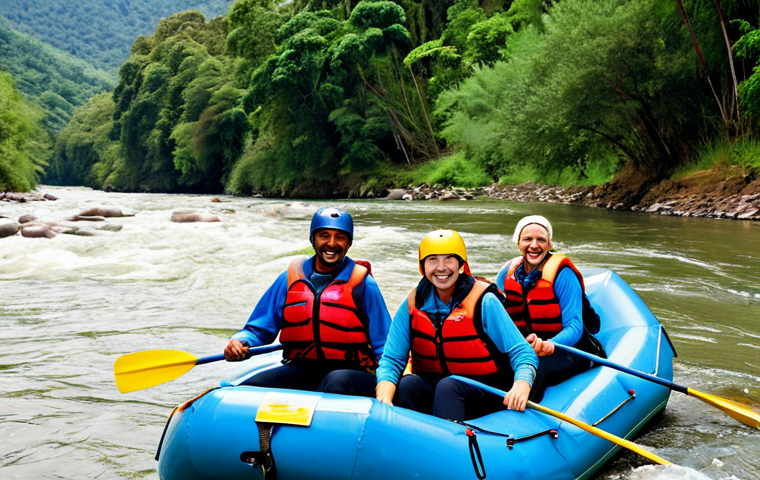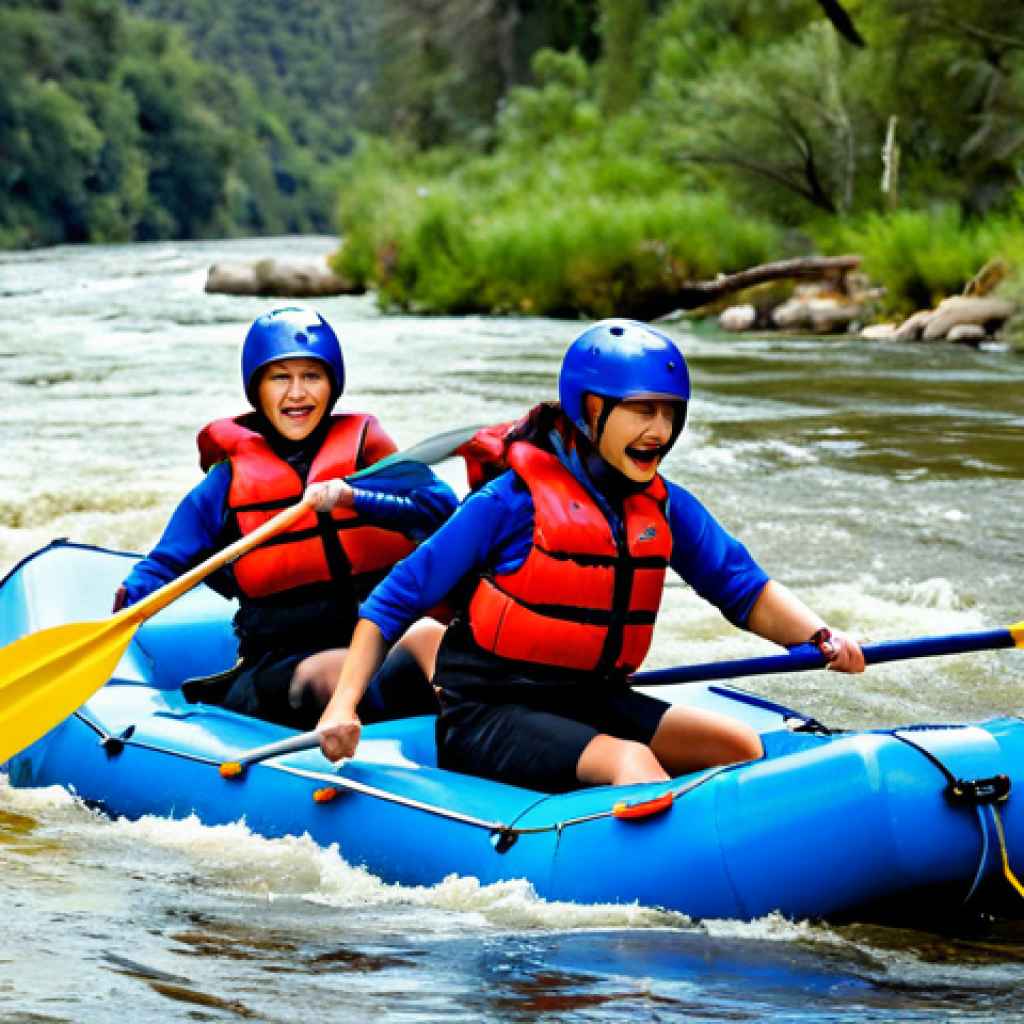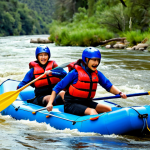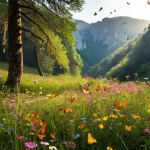There’s nothing quite like the rush of whitewater, the spray on your face, and the collective exhilaration as you navigate powerful rapids. I’ve been fortunate enough to experience this thrill firsthand on many rivers, and the Nerumba River truly stands out.
It’s a spectacular stretch of water, renowned for its challenging yet accessible rapids that cater to both seasoned adventurers and eager first-timers.
But let me tell you, as someone who’s seen it all, the success and safety of your rafting trip hinge almost entirely on one crucial element: your guide.
I recall one particular descent where unexpected water levels shifted our route mid-stream; our guide, calm and collected, made split-second decisions that not only kept us safe but turned a potentially hazardous situation into an unforgettable display of expert navigation.
It really underscored for me the irreplaceable value of a knowledgeable, experienced leader on the water. With eco-tourism on the rise, we’re seeing a shift towards more sustainable and localized guiding practices, emphasizing not just the thrill but also the preservation of these incredible natural environments.
Future trends point towards even more personalized experiences, potentially leveraging smart tech for real-time water condition updates, making the guide’s role even more dynamic.
Understanding what makes an exceptional Nerumba River rafting guide isn’t just about finding someone who knows the river; it’s about finding a true guardian of your adventure.
Let’s dive deeper below.
Decoding the River’s Whisper: More Than Just Navigational Skills

The Nerumba River, with its unpredictable currents and hidden eddies, demands more than just a superficial understanding of whitewater. I remember a particularly challenging stretch, the “Devil’s Jaw,” where the water churns violently.
My guide, Sarah, didn’t just tell us to paddle hard; she read the water like an open book, pointing out subtle changes in the surface tension and the faint sound of a submerged rock before anyone else even registered it.
This isn’t something you learn from a textbook; it’s an intuitive connection forged over countless descents, feeling the river’s pulse in your very bones.
It’s about knowing how the water will react to different raft placements, anticipating the impact of a sudden gust of wind, and understanding the nuances of the riverbed you can’t even see.
I’ve witnessed guides who could recite every rapid name and rating, but lacked this innate sense, leading to choppy, less controlled descents. A truly exceptional guide possesses an almost symbiotic relationship with the river, a profound respect for its power, and an ability to translate its complex language into actionable commands for their crew.
This mastery extends to recognizing the subtle shifts that indicate changing water levels or potential hazards, allowing them to adjust the route mid-run with an almost supernatural calm.
It’s this deep, almost spiritual connection that separates the good from the truly legendary.
Embracing the Unseen: Reading the River’s Subtle Cues
The best guides don’t just react to the rapids; they anticipate them, reading the subtle clues the river provides long before the raft enters a chaotic section.
From my own experiences, I’ve learned to watch how a guide’s eyes constantly scan the water ahead, picking up on the minute details that predict the flow.
They’re looking for things like:
* Swirls and eddies: These indicate hidden obstacles or strong undertows. * Water color variations: Can signal depth changes or sediment.
* Sound of the rapids: A different roar might mean a new, powerful feature. They understand that every ripple, every change in the current’s rhythm, tells a story about what lies beneath and what’s coming next.
It’s like a finely tuned instrument, sensing the slightest alteration in the river’s melody.
Beyond the Map: Intuitive Route Selection in Dynamic Conditions
While maps and pre-trip briefings are essential, the Nerumba is a living, breathing entity that changes daily, sometimes hourly, depending on rainfall, dam releases, and even recent geological shifts.
A guide’s real skill shines when they have to deviate from the planned route, making real-time adjustments based on current conditions. I recall a trip where heavy rains overnight swelled the river considerably; our guide, instead of sticking to the usual line, deftly navigated us through a series of smaller channels that were safer and still exhilarating, avoiding a newly formed, treacherous hydraulic that would have been a nightmare.
This isn’t just about knowing the main channel; it’s about intimate familiarity with every nook and cranny, every alternative path, and the confidence to choose the best one on the fly.
It’s an art form, really, born from countless hours on the water, observing and learning.
The Unsung Heroes of Safety: Prepping for the Unforeseen
When you’re out on the Nerumba, a sense of controlled chaos is often part of the fun, but behind that exhilaration is a meticulously orchestrated safety protocol.
I’ve seen guides who treat safety briefings like an afterthought, rushing through them to get to the “exciting” part. That’s a huge red flag for me. The truly professional guides on the Nerumba take the time, patiently explaining every scenario, from proper paddling techniques to what to do if you unexpectedly find yourself in the water.
They don’t just recite facts; they demonstrate, they engage, and they ensure every single person understands the gravity and the simplicity of their instructions.
I particularly appreciate guides who emphasize the “why” behind each safety measure, making it click in your mind. It’s this dedication to thorough preparation that allows you to fully immerse yourself in the experience, knowing that an expert is constantly assessing risks and ready to act.
Their calm demeanor under pressure, honed by years of experience, is perhaps their most comforting safety tool. They are the guardians of our adventure, ensuring our thrills are always tempered by unwavering vigilance.
The Art of the Pre-Trip Briefing: Setting the Stage for Success
A comprehensive safety briefing isn’t just a formality; it’s the bedrock of a safe and enjoyable rafting trip. A top-tier Nerumba guide will cover far more than just basic commands.
My favorite guides always spend ample time on:
* Emergency procedures: What to do if someone falls out, how to self-rescue, and how to help others. * Communication signals: Hand signals, verbal calls, and how to interpret the guide’s instructions over the roar of the rapids.
* Equipment familiarization: Ensuring everyone knows how to properly wear a PFD (personal flotation device) and hold a paddle. They ask questions, encourage participation, and address anxieties, ensuring everyone feels prepared and confident before even touching the water.
It’s about building a collective understanding and readiness.
Rapid Response: Mastering On-Water Emergencies
No matter how well you plan, things can go wrong on a whitewater river. This is where a guide’s true mettle is tested. I’ve been in a raft that flipped on a particularly tricky rapid (my own misjudgment, not the guide’s!), and the seamless, almost instantaneous response of our guide, Mark, was incredible.
He had us all accounted for, safely back in the boat, and ready to continue in what felt like mere seconds. It wasn’t just luck; it was:
* Pre-planned rescue techniques: Knowing exactly where to position the raft for a quick retrieval.
* Calm under pressure: His voice remained steady, reassuring us even as we were scrambling. * Prioritizing safety: Ensuring everyone was unharmed before thinking about anything else.
This kind of practiced, automatic reaction comes only from extensive training and genuine, lived experience in high-stress situations. It’s the difference between a minor incident and a serious problem.
Beyond the Paddle Stroke: Cultivating a Memorable Experience
While the thrill of the rapids is undoubtedly the main draw, what truly elevates a Nerumba River rafting trip into an unforgettable memory is the guide’s ability to infuse the journey with personality and unexpected joy.
I’ve been on trips where the guide was purely functional – efficient, yes, but devoid of warmth or engagement. And then there are guides like Emily, who I rafted with last summer.
She didn’t just tell us when to paddle; she cracked jokes, shared fascinating local legends about the surrounding cliffs, and even led a spontaneous sing-along during a calm stretch.
These little touches, these moments of shared humanity, transform a simple ride down the river into a shared adventure, a bonding experience. It’s about creating an atmosphere where laughter is as abundant as the whitewater spray, where every moment feels unique and personalized.
A great guide understands that people come for the adrenaline, but they stay and return for the connection and the stories they can tell afterwards. This personal touch, this genuine enthusiasm, is what turns a good trip into a legendary one that you’ll recount for years.
Engaging Storytelling: Weaving Narratives into the Journey
The Nerumba River flows through a region rich in history and natural beauty, and the best guides are master storytellers, transforming the landscape around you into a living narrative.
They don’t just point out landmarks; they breathe life into them. I vividly remember a guide who, during a quiet stretch, shared a thrilling account of how the local indigenous people used to navigate these very waters, describing their ancient techniques and the challenges they faced.
This wasn’t a dry history lesson; it was an immersive experience that deepened my appreciation for the river and its heritage. They often share:
* Local folklore: Tales of mythical creatures or historical figures tied to specific river points.
* Geological insights: Explanations of how the canyons were formed and the types of rocks you see. * Wildlife anecdotes: Stories about the eagles soaring above or the fish in the clear waters.
These stories add layers of meaning to the journey, making it far more enriching than just a physical challenge.
Building Camaraderie: The Guide as a Team Facilitator
A rafting trip is inherently a team effort, and a skilled guide acts as an expert facilitator, subtly encouraging connection and camaraderie among the crew, even if they’re strangers.
I’ve been on trips where awkward silences permeated the calm stretches, but with a truly great guide, that never happens. They’ll initiate lighthearted conversations, encourage everyone to share a funny anecdote, or even organize mini-games during flat sections.
They have a knack for sensing the group’s dynamic and gently steering it towards a more cohesive, joyful experience. They also expertly manage different personalities, ensuring everyone feels heard and valued, fostering a sense of shared purpose as you tackle the rapids together.
It’s this ability to forge a temporary community that makes the journey truly special.
Local Lore and Living History: Why Hyper-Local Knowledge Matters
The Nerumba isn’t just a river; it’s a vibrant ecosystem interwoven with the lives and histories of the communities along its banks. Anyone can study a map, but a truly exceptional guide brings the river to life through a deep understanding of its local context.
I’ve always found that the most memorable trips are those where the guide shares insights that you simply can’t Google. For example, my guide, a lifelong local named Ben, pointed out specific trees that provided traditional medicinal herbs and told us about the changing patterns of salmon migration due to historical damming projects further upstream.
This hyper-local knowledge isn’t just interesting trivia; it fosters a deeper appreciation for the environment and the delicate balance of the ecosystem.
It highlights their authority and trustworthiness because they aren’t just reciting facts; they’re sharing lived experience and generational wisdom. This connection to the land and its people elevates the rafting experience from a mere adrenaline rush to a cultural immersion, providing context and meaning to every bend in the river.
It’s this genuine rootedness that earns your trust and respect.
Indigenous Wisdom: Respecting the River’s Ancient Heritage
The Nerumba River has been traversed by indigenous peoples for centuries, and a guide who understands and respects this ancient heritage adds immense depth to the experience.
I was once on a trip where our guide explained the traditional names of certain rapids and shared how the local tribes viewed the river as a sacred lifeblood.
This reverence for the land, passed down through generations, made me see the Nerumba not just as a playground, but as a place of profound spiritual significance.
It’s about acknowledging the first stewards of the land and their enduring connection to it.
Economic Impact and Community Ties: Rafting’s Role in Local Life
A truly knowledgeable local guide often provides insights into how rafting impacts the local economy and community, highlighting the symbiotic relationship between tourism and conservation.
They might talk about local initiatives to protect the river, the jobs created by the rafting industry, or even recommend local eateries and artisan shops.
This kind of information connects your adventure directly to the well-being of the region.
| Quality | Description | Why it Matters for Nerumba Rafting |
|---|---|---|
| River Mastery | Deep, intuitive understanding of currents, hazards, and alternative routes. | Ensures safe navigation through challenging rapids and adapts to changing river conditions. |
| Safety Protocols | Thorough pre-trip briefings, emergency response, and equipment checks. | Builds confidence and prepares all participants for potential incidents, minimizing risks. |
| Engaging Persona | Humor, storytelling, and ability to foster group camaraderie. | Transforms a trip into a memorable, joyful experience, encouraging return visits. |
| Local Expertise | Knowledge of local history, ecology, culture, and community. | Enriches the experience beyond just rafting, connecting participants to the region. |
| Environmental Ethic | Commitment to Leave No Trace principles and conservation efforts. | Ensures the Nerumba River remains pristine for future generations of adventurers. |
Fostering the Future: Eco-Conscious Guiding on the Nerumba
In an era where environmental awareness is more crucial than ever, a responsible Nerumba River guide isn’t just about navigating rapids; they are also staunch advocates for the preservation of this incredible natural resource.
I’ve noticed a significant shift in recent years, with the best outfitters and guides genuinely embodying the “Leave No Trace” principles. My favorite guides don’t just talk the talk; they walk the walk.
On one trip, our guide, Sarah, paused during a quiet stretch to collect a piece of discarded plastic that had washed ashore, taking the time to explain to us the impact even small pieces of litter have on the river’s ecosystem.
This wasn’t a preachy lecture; it was a simple, powerful demonstration of respect for the environment. They teach you, by example, how to be a responsible visitor, how to minimize your footprint, and why it’s so important to protect these wild spaces.
It’s about instilling a sense of stewardship in every participant, making us all guardians of the gorge. This commitment to sustainability is crucial for the long-term health of the river and the continued enjoyment of future generations, cementing their authority as environmental stewards.
Leave No Trace Principles: Practicing Sustainable Adventure
A truly great Nerumba guide educates their clients on responsible outdoor practices, making sure the beauty of the river is preserved for everyone. They integrate these principles seamlessly into the trip:
* Waste management: Explaining how all waste, even organic matter, must be packed out.
* Wildlife interaction: Emphasizing observing wildlife from a distance and not disturbing their habitats. * Campsite ethics: If multi-day trips are involved, showing how to minimize impact on riverbanks.
This hands-on education ensures that every adventurer contributes to the river’s health, turning the trip into a lesson in environmental responsibility.
Conservation Advocacy: Guides as River Protectors
Many Nerumba guides go beyond simply following rules; they actively participate in conservation efforts and advocate for the river’s protection. I’ve encountered guides who volunteer for river clean-up days, educate local communities about water quality, or even lobby for policies that safeguard the river from pollution and over-development.
Their passion for the river extends far beyond their job, demonstrating a deep personal commitment that instills trust and respect in their clients. They often share specific examples of how they or their company are contributing to local conservation, making you feel part of a larger, positive movement.
The Human Element: Building Trust and Camaraderie on the Water
Beyond all the technical skills and ecological knowledge, the ultimate measure of an exceptional Nerumba River guide lies in their ability to connect with people.
I’ve been on trips where the guide was technically proficient but lacked that certain spark, leaving the group feeling somewhat disconnected. Conversely, the best guides possess an almost uncanny ability to read the room, understand individual anxieties, and foster a genuine sense of camaraderie among strangers.
I recall a first-timer on one of my trips who was visibly nervous; our guide, Sarah, quietly spent a few extra minutes explaining things to her, offering gentle encouragement, and by the end of the trip, that same person was laughing and high-fiving everyone.
It’s this emotional intelligence, this genuine care for each person’s experience, that transforms a thrilling ride into a deeply personal and meaningful adventure.
They aren’t just leading a boat; they’re orchestrating a shared human experience, building a temporary community on the water, and ensuring everyone feels safe, included, and exhilarated.
This personal touch is why you remember their names long after the trip is over, and why you feel compelled to recommend them to others.
Reading the Group: Adapting to Diverse Personalities and Skill Levels
A great guide understands that every group is unique, comprising individuals with varying levels of experience, comfort, and expectations. They don’t apply a one-size-fits-all approach.
I’ve seen guides subtly adjust their pacing, their instructions, and even their humor to match the group’s vibe. They recognize:
* Anxiety: Identifying nervous participants and offering extra reassurance.
* Enthusiasm: Leaning into the excitement of more adventurous individuals. * Physical limitations: Adapting instructions for those with less strength or mobility.
This adaptability ensures that everyone, from the seasoned veteran to the first-time rafter, feels challenged yet supported, included and comfortable throughout the journey.
It’s like they have an invisible antenna for human connection.
From Strangers to Friends: Facilitating Shared Experiences
The magic of whitewater rafting is often in the shared experience, and an excellent guide acts as a catalyst for this. They create an environment where strangers can quickly bond, overcoming challenges together and celebrating successes.
I’ve made lasting friendships on rafting trips, thanks in no small part to guides who encouraged interaction and shared laughter. They might:
* Initiate lighthearted conversations during calm stretches.
* Encourage high-fives and celebratory shouts after a big rapid. * Share personal anecdotes that invite others to do the same. This ability to foster genuine connection means that by the end of the trip, you’re not just a group of individuals who shared a raft, but a temporary team, forged in the thrilling currents of the Nerumba.
Closing Thoughts
So, when you’re planning your next whitewater adventure on a river like the Nerumba, remember that the true magic isn’t just in the roar of the rapids or the breathtaking scenery.
It’s profoundly shaped by the person at the stern of your raft. An exceptional guide transforms a thrill ride into a profound journey, blending expert navigation with a genuine passion for the river and an innate ability to connect with people.
They are the unsung heroes who ensure your safety, ignite your sense of wonder, and create those indelible memories you’ll recount for years to come. Choose wisely, and your Nerumba experience will be nothing short of legendary.
Useful Information to Know
1. Best Time to Go: For most whitewater rivers in the US, prime rafting season typically runs from late spring (May) through early fall (September). Early season often brings higher, more exciting water levels from snowmelt, while later in the summer offers warmer water and generally more consistent flows. Always check with outfitters for specific river conditions.
2. What to Wear and Bring: Dress in quick-drying materials like synthetics or wool – avoid cotton, as it stays wet and can make you cold. Essential items include swimwear, shorts/t-shirt, a hat, sunglasses with a strap, sunscreen, and secure footwear (water shoes or old sneakers, no flip-flops!). Many outfitters provide wetsuits and splash jackets for colder days.
3. Booking and Choosing an Outfitter: Research reputable outfitters with strong safety records and positive reviews. Don’t hesitate to call and ask about their guides’ experience and training. A good outfitter will be transparent about their safety protocols and what to expect on the trip. Look for companies that prioritize both adventure and environmental stewardship.
4. Fitness Level: While most commercial rafting trips cater to a range of fitness levels, a basic level of physical fitness is generally recommended. You’ll need to be able to paddle, hold on tightly, and potentially scramble back into the raft if you fall out. If you have any medical conditions, it’s crucial to inform your outfitter beforehand.
5. Tipping Your Guide: In the US, it’s customary to tip your whitewater rafting guide, much like you would a server or other service professional. A general guideline is 15-20% of the trip cost per person, especially if you felt they provided an exceptional experience. Guides work incredibly hard to ensure your safety and enjoyment, and tips are a significant part of their income.
Key Takeaways
An exceptional Nerumba River guide combines unparalleled river mastery with rigorous safety protocols, ensuring both thrilling adventure and peace of mind.
They elevate the experience through engaging storytelling and fostering genuine camaraderie among participants. Crucially, their deep local expertise and strong commitment to environmental stewardship enrich the journey and build lasting trust, transforming a simple rafting trip into an unforgettable, human-centered exploration of the wild.
Frequently Asked Questions (FAQ) 📖
Q: How crucial is the guide’s experience for someone new to whitewater rafting on the Nerumba River, given its reputation for both challenging and accessible rapids?
A: Oh, it’s absolutely paramount, especially if you’re a first-timer or even just feeling a bit rusty! My personal experience, having navigated countless rivers, has hammered home that a seasoned guide on the Nerumba isn’t just a luxury; they’re your lifeline and your key to unlocking the true joy of the river.
You see, while the Nerumba is fantastic because it does cater to different skill levels, those ‘challenging’ sections can turn from thrilling to genuinely daunting in a heartbeat, particularly with unexpected shifts in water levels – something I’ve personally witnessed.
A truly experienced guide won’t just tell you when to paddle; they’ll read the water like an open book, anticipating every current and eddy. They make those split-second decisions that keep everyone safe and turn what could be a hairy moment into an incredible story.
For a beginner, this expertise translates directly into confidence. You can truly relax, immerse yourself in the natural beauty, and feel the rush, knowing someone with a deep understanding of the river is expertly navigating every twist and turn.
It transforms the experience from a potential worry into pure, unadulterated exhilaration.
Q: Beyond just navigating the rapids, what specific qualities should rafters prioritize when choosing an exceptional Nerumba River guide for their adventure?
A: That’s a brilliant question, because knowing the river is just the entry ticket; an exceptional guide offers so much more. From my perspective, having been on countless trips, I look for a unique blend of qualities.
First, it’s their judgment – not just about the water, but about the group dynamic. A great guide can read the mood of the raft, sense when someone’s nervous, and offer reassurance or a well-timed joke.
Then there’s their genuine passion for the environment. You can feel it when a guide truly loves the river and its surroundings; they’ll share fascinating insights about the local wildlife, geology, or the history of the area, making the trip so much richer than just the physical activity.
It’s also about their communication style. Are they clear, calm, and able to convey instructions effectively under pressure? And crucially, I’ve found that the best guides are deeply involved in local community and sustainable practices.
They’re not just passing through; they’re invested in preserving the Nerumba. They’ll subtly educate you on eco-friendly practices, like ‘Leave No Trace’ principles, ensuring that the beauty we experience today is there for generations to come.
It’s this holistic approach – safety, education, personality, and environmental stewardship – that truly defines a guardian of your adventure.
Q: With the rise of eco-tourism and mentions of smart tech, how are these trends practically influencing or shaping a typical Nerumba River rafting trip?
A: It’s fascinating to watch these shifts unfold firsthand, and on the Nerumba, you can really see the impact. On the eco-tourism front, guides are increasingly focused on minimal impact practices.
It’s less about just running rapids and more about fostering a respect for the environment. This means things like strict waste management protocols – everything, and I mean everything, comes off the river with us.
You’ll find guides emphasizing not disturbing wildlife, staying on designated paths during breaks, and even participating in river clean-up efforts on their off days.
It’s a tangible commitment to preservation. As for smart tech, while it’s not about robots guiding your raft yet, it’s definitely enhancing the experience behind the scenes.
Guides are leveraging real-time weather and water level data, often accessed through robust, waterproof devices, to make more informed decisions before and during the trip.
This means more precise route planning, better awareness of potential hazards, and ultimately, a safer and more optimized adventure. I’ve seen some outfitters even experimenting with personalized post-trip content, like geo-tagged photos and videos, which makes the memories even more vivid.
It truly makes the guide’s role more dynamic, blending their inherent river wisdom with cutting-edge information to ensure every trip is as safe, thrilling, and environmentally conscious as possible.
📚 References
Wikipedia Encyclopedia
구글 검색 결과
구글 검색 결과
구글 검색 결과
구글 검색 결과
구글 검색 결과





